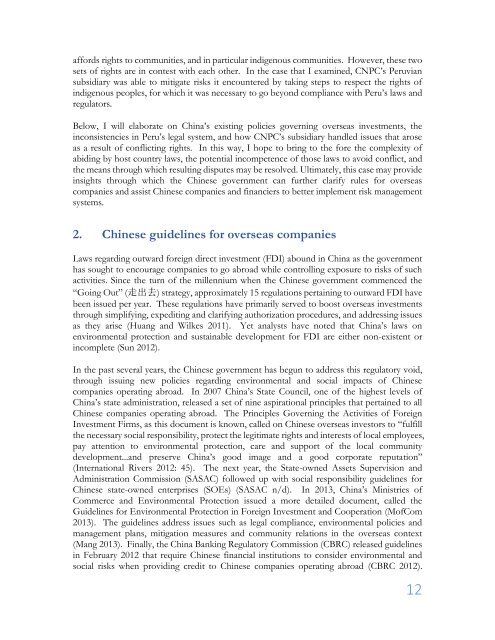Yale-WWF_final
Yale-WWF_final
Yale-WWF_final
You also want an ePaper? Increase the reach of your titles
YUMPU automatically turns print PDFs into web optimized ePapers that Google loves.
affords rights to communities, and in particular indigenous communities. However, these twosets of rights are in contest with each other. In the case that I examined, CNPC’s Peruviansubsidiary was able to mitigate risks it encountered by taking steps to respect the rights ofindigenous peoples, for which it was necessary to go beyond compliance with Peru’s laws andregulators.Below, I will elaborate on China’s existing policies governing overseas investments, theinconsistencies in Peru’s legal system, and how CNPC’s subsidiary handled issues that aroseas a result of conflicting rights. In this way, I hope to bring to the fore the complexity ofabiding by host country laws, the potential incompetence of those laws to avoid conflict, andthe means through which resulting disputes may be resolved. Ultimately, this case may provideinsights through which the Chinese government can further clarify rules for overseascompanies and assist Chinese companies and financiers to better implement risk managementsystems.2. Chinese guidelines for overseas companiesLaws regarding outward foreign direct investment (FDI) abound in China as the governmenthas sought to encourage companies to go abroad while controlling exposure to risks of suchactivities. Since the turn of the millennium when the Chinese government commenced the“Going Out” ( 走 出 去 ) strategy, approximately 15 regulations pertaining to outward FDI havebeen issued per year. These regulations have primarily served to boost overseas investmentsthrough simplifying, expediting and clarifying authorization procedures, and addressing issuesas they arise (Huang and Wilkes 2011). Yet analysts have noted that China’s laws onenvironmental protection and sustainable development for FDI are either non-existent orincomplete (Sun 2012).In the past several years, the Chinese government has begun to address this regulatory void,through issuing new policies regarding environmental and social impacts of Chinesecompanies operating abroad. In 2007 China’s State Council, one of the highest levels ofChina’s state administration, released a set of nine aspirational principles that pertained to allChinese companies operating abroad. The Principles Governing the Activities of ForeignInvestment Firms, as this document is known, called on Chinese overseas investors to “fulfillthe necessary social responsibility, protect the legitimate rights and interests of local employees,pay attention to environmental protection, care and support of the local communitydevelopment...and preserve China’s good image and a good corporate reputation”(International Rivers 2012: 45). The next year, the State-owned Assets Supervision andAdministration Commission (SASAC) followed up with social responsibility guidelines forChinese state-owned enterprises (SOEs) (SASAC n/d). In 2013, China’s Ministries ofCommerce and Environmental Protection issued a more detailed document, called theGuidelines for Environmental Protection in Foreign Investment and Cooperation (MofCom2013). The guidelines address issues such as legal compliance, environmental policies andmanagement plans, mitigation measures and community relations in the overseas context(Mang 2013). Finally, the China Banking Regulatory Commission (CBRC) released guidelinesin February 2012 that require Chinese financial institutions to consider environmental andsocial risks when providing credit to Chinese companies operating abroad (CBRC 2012).12


